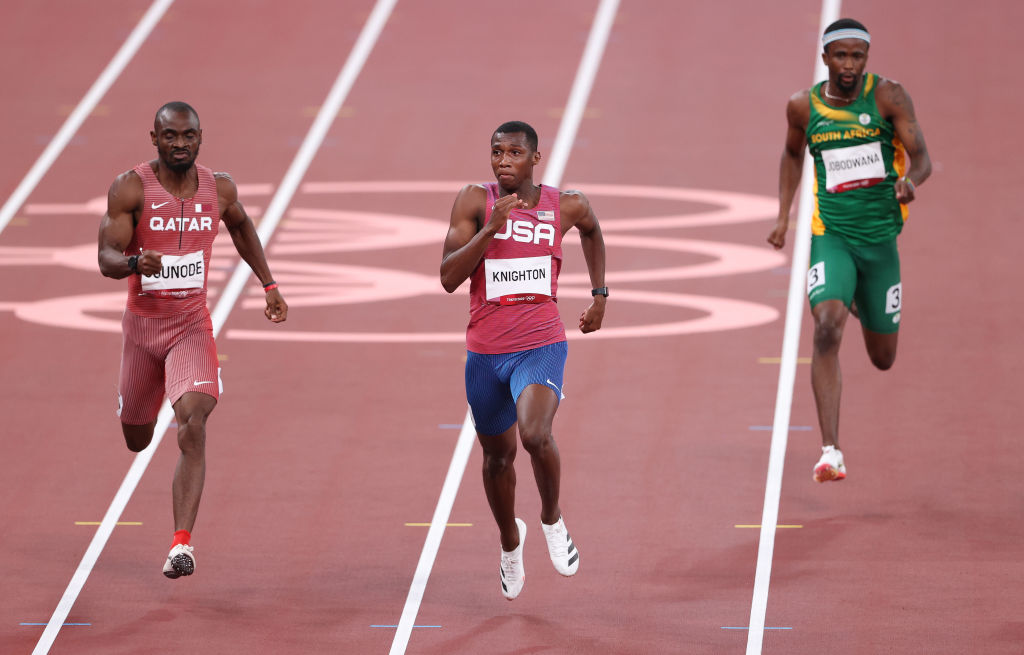The race to Eugene is on and men’s sprinting is hotly contested

The long-standing successes of US collegiate sports are well known. The countless NFL players, the basketball stars and, of course, the seemingly endless prominence in the world of track athletics.
This year is no different, and while all of the athletes may not be American in nationality, it’s in the United States where the majority of the fastest times are currently being set.
Ghanaian duo Benjamin Azamati-Kwaku and Joseph Paul Amoah have clocked sub-10 second 100m times this year competing in Texas and Maryland respectively.
Kenyan Ferdinand Omanyala clocked a world leading 9.85 seconds into a headwind in Nairobi at the weekend while, at the same event, American Fred Kerley ran 9.92.
The eight fastest this year all clocked their times running into the wind – a sign of the potential to come.
In the men’s 200m, all but one of the top 10 times so far this year is American. The outlier is Liberia’s Joseph Fahnbulleh – and that was set in Florida.
At the top of the list when it comes to the men’s half-lap race is Erriyon Knighton. The American’s 19.49 time, set last month, puts him as the fourth fastest 200m runner of all time – behind only Usain Bolt, Michael Johnson and Yohan Blake.
But in the States, and across the world, there’s a focus point in the season: the World Championships.
Having been controversially handed the right to host the showpiece event, Eugene, Oregon – the modest city perhaps best known for being the home of Nike – will stage the championships in late July.
This has concentrated minds throughout track and field, and athletes are looking to peak in time for the event.
While age-group records seem to be falling left, right and centre – including Letsile Tebogo breaking the world junior record for the men’s 100m in Botswana – the competition means that there are so many athletes within such fine margins of one another that the qualification times for Eugene could be extremely fast.
For European athletes, whose outdoor season doesn’t completely start until next week’s Diamond League, there will be an urgency to get up to speed and consistently post impressive times to lay down a marker to those over the water.
Three records tumbled at last year’s Tokyo Olympics, which was held outside of the usual cycle due to the Covid-19 pandemic: two in the 400m hurdles – Sydney McLaughlin and Karsten Warholm – and Yulimar Rojas in the women’s triple jump.
But with these World Championships held in their long-planned date, the current fast times are likely to be signs of athletes beginning to peak for the competition.
Another important factor is that many athletes will have just completed their first ‘normal’ winter since the pandemic.
Winter training is paramount to a successful outdoor season. Athletes often target the summer period as a competition phase while using the winter to better their skillset.
One US track coach who did not want to be named told City A.M. that “the advancement in training, technology – the new ‘super spike’ [generation of running shoes] – and the surfaces” is going to keep fueling the competition across the States.
As more colleges in the States invest in high-spec sporting facilities, access for aspiring athletes nationwide becomes easier.
We might, then, expect to see competition margins narrow for the remainder of the preparation period before the World Championships.
It would be no surprise if records tumbled in Eugene. But with the current competitiveness, it’s not impossible that any record set in July would need to better one set between now and the first starting gun at the World Championships.